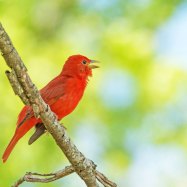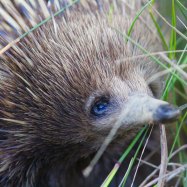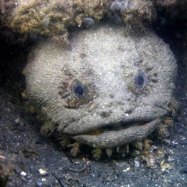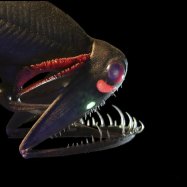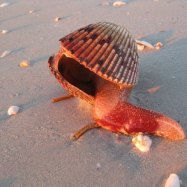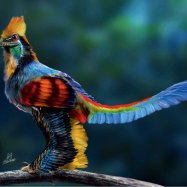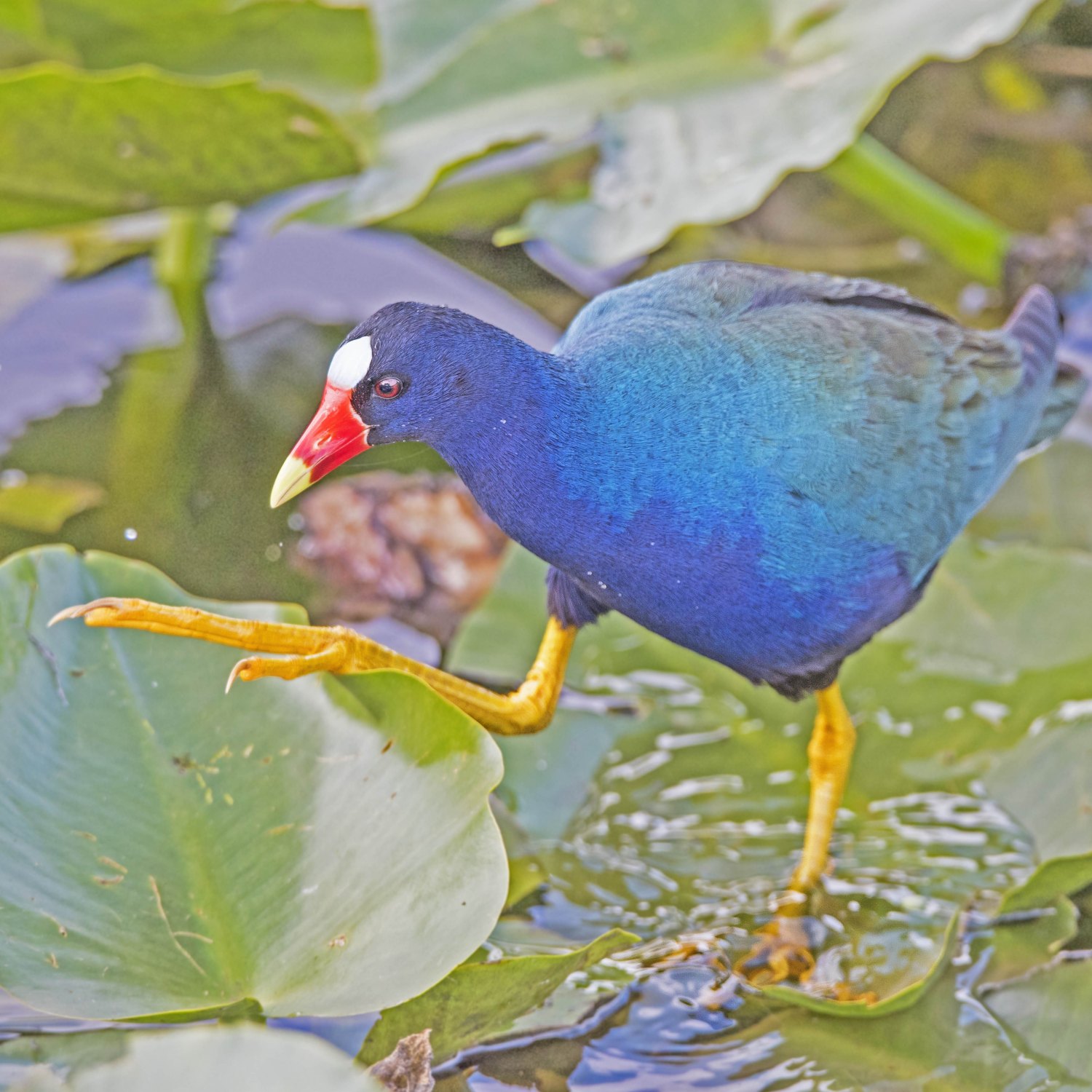
Purple Gallinule
28 to 35 cm (11 to 14 inches)
The Purple Gallinule, found in the Southern US, Central America, and South America, is a medium-sized bird with a distinct purple and green plumage. This beautiful member of the Rallidae family can grow up to 14 inches in length and has a long neck and legs, making it a truly unique sight to see in its natural habitat. Keep your eyes peeled for this colorful creature on your next nature walk! #PurpleGallinule #SouthernUS #BirdWatching
Animal Details Summary:
Common Name: Purple Gallinule
Kingdom: Animalia
Habitat: Freshwater marshes, swamps, and wetlands
The Beautiful and Mystical Purple Gallinule: A Colorful Bird of the Americas
In the vast and diverse world of avian species, one bird stands out for its striking colors and elusive nature – the Purple Gallinule. With its vibrant purple and blue feathers, this bird is a sight to behold, and its behavior and habitat add to its allure. So, let's take a closer look at this magnificent creature and learn more about its unique features.The Basics: Scientific Classification and Habitat
The Purple Gallinule belongs to the family Rallidae, which includes water birds such as rails, crakes, and coots Purple Gallinule. Its scientific name is Porphyrio martinicus, and it is commonly known as Purple Gallinule. The word "porphyrio" is derived from the Greek word "porphura," meaning purple, which aptly describes the bird's color.This species can be found in freshwater marshes, swamps, and wetlands of both North and South America. Its natural habitat range includes the United States, Mexico, Central America, and South America. However, it is more frequently seen in the southern United States, Central America, and South America.
An Omnivorous Diet
The Purple Gallinule is an omnivore, meaning it feeds on both plants and animals. Its diet consists of a variety of aquatic vegetation, including water lilies, algae, and duckweed. Additionally, it also eats small invertebrates such as snails, spiders, and insects. These birds are known to forage both on land and in the water, using their long legs and toes to move through shallow water and pick food from the surface Parrot.The Mystical Coloration
One of the most distinctive features of the Purple Gallinule is its vibrant coloration. Its plumage is mainly shades of purple and blue, with hints of green and yellow. The bird's head, neck, and breast are a deep velvety purple, while its back, wings, and tail feathers are a glossy blue. Its underparts are a bright yellow-green, and it has a bright red bill with a yellow tip. These unique colors make the Purple Gallinule easily recognizable and have earned it the nickname "the rainbow bird."The purpose of these bright colors is twofold. They serve as a way for the birds to attract mates during breeding season, and also act as camouflage in their natural habitat. When perched on a purple or green plant, the bird's coloration blends perfectly, making it invisible to potential predators.
A Medium-Sized Bird with Unique Body Features
With a length of 28 to 35 cm (11 to 14 inches), the Purple Gallinule is considered a medium-sized bird. However, what sets it apart from other birds is its long neck and legs. These body features have adapted to its marshy habitat and help it navigate through the shallow water with ease.The bird's long toes and curved claws also play a crucial role in its feeding habits. They allow the bird to grip onto wet vegetation while foraging for food, and also help it swim through the water.
Conservation Status
Unfortunately, like many other bird species, the Purple Gallinule has faced a decline in population due to habitat destruction. Its freshwater marshland habitats have been drained for agriculture and development purposes, making it difficult for these birds to sustain their populations. Additionally, they are also sometimes hunted for their colorful feathers, which are used in traditional costumes and ornaments.However, efforts are being made to conserve this beautiful bird, especially in the United States, where it is considered a sensitive species. Conservation organizations are working towards preserving wetlands and creating protected areas for these birds to thrive. With these efforts, the Purple Gallinule's population is slowly recovering, giving hope for a better future for this unique species.
Folklore and Superstitions
Throughout history, the Purple Gallinule has been associated with mysticism and folklore. The Aztecs, a civilization from central Mexico, regarded this bird as a sacred messenger of their rain god, Tlaloc. Similarly, the indigenous people of Venezuela believed that seeing a Purple Gallinule was a sign of rain and good luck.On the other hand, European sailors feared encountering this bird on their voyages, believing it to be an omen of bad luck and stormy seas. These superstitions may have stemmed from the bird's love for marshlands, which were often associated with mythical creatures and tumultuous waters.
Why You Should Look Out for the Purple Gallinule
The Purple Gallinule is not only a beautiful and mystical bird, but it also plays a vital role in its ecosystem. As an omnivore, it helps balance the aquatic vegetation, keeping the waterways healthy and thriving. Its unique body features and colorful plumage make it an exciting subject for bird watchers and photographers.Moreover, the presence of Purple Gallinules is an indicator of the health of their freshwater habitats. So, if you spot these birds on your next nature walk, admire them from a distance and know that they are a symbol of a flourishing ecosystem.
In conclusion, the Purple Gallinule is a magnificent and mystical bird that adds beauty to its surroundings. With its unique coloration and elusive behavior, it has captured the curiosity and imagination of bird enthusiasts worldwide. Let us continue to appreciate and preserve this colorful creature, ensuring its existence for generations to come.

Purple Gallinule
Animal Details Purple Gallinule - Scientific Name: Porphyrio martinicus
- Category: Animals P
- Scientific Name: Porphyrio martinicus
- Common Name: Purple Gallinule
- Kingdom: Animalia
- Phylum: Chordata
- Class: Aves
- Order: Gruiformes
- Family: Rallidae
- Habitat: Freshwater marshes, swamps, and wetlands
- Feeding Method: Omnivorous
- Geographical Distribution: North and South America
- Country of Origin: United States, Mexico, Central America, and South America
- Location: Southern United States, Central America, and South America
- Animal Coloration: Mainly purple and blue with green and yellow
- Body Shape: Medium-sized with a long neck and legs
- Length: 28 to 35 cm (11 to 14 inches)
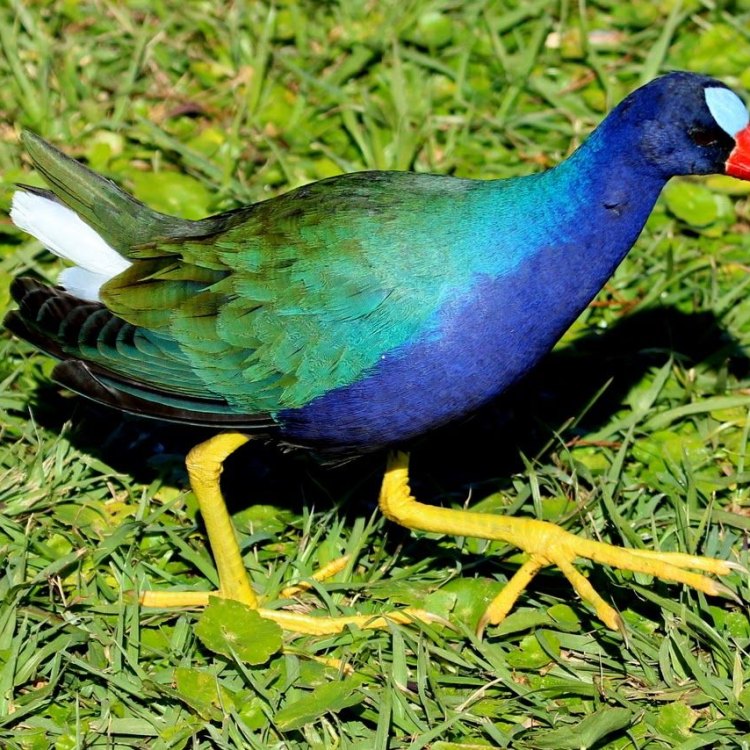
Purple Gallinule
- Adult Size: Small to medium
- Average Lifespan: 2 to 5 years in the wild
- Reproduction: Sexual
- Reproductive Behavior: Monogamous
- Sound or Call: Loud, repetitive call
- Migration Pattern: Sedentary
- Social Groups: Solitary or in small groups
- Behavior: Active during the day (diurnal) and forages in dense vegetation
- Threats: Habitat loss and degradation, predation, pollution
- Conservation Status: Least Concern
- Impact on Ecosystem: Seed dispersal
- Human Use: No significant human use
- Distinctive Features: Brightly colored plumage and long toes
- Interesting Facts: Purple Gallinules are excellent swimmers and can walk on floating vegetation
- Predator: Snakes, birds of prey, and mammals
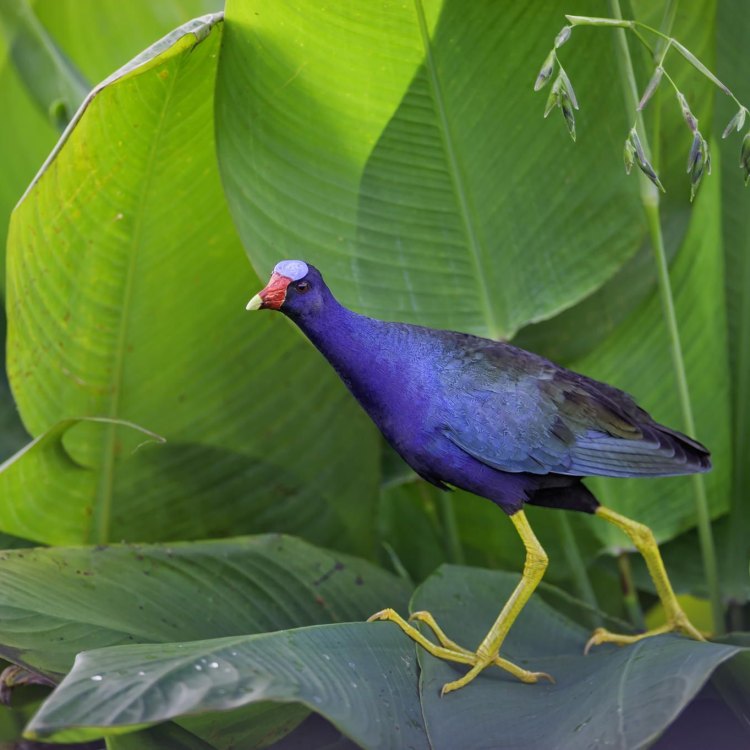
Porphyrio martinicus
The Majestic Purple Gallinule: A Colorful Gem of the Wetlands
Nestled deep within the lush, marshy wetlands of the Americas, lies a bird that is truly a sight to behold – the Purple Gallinule. With its vibrant plumage, long toes, and unique behaviors, this small to medium-sized bird has captured the attention and hearts of birdwatchers and nature enthusiasts alike.Let us take a closer look at this captivating avian species and uncover the fascinating facts that make it stand out in the wild.
The Basics – What You Need to Know About the Purple Gallinule
The Purple Gallinule, scientifically known as Porphyrio martinica, is a member of the rail family and can be found in the United States, Central, and South America PeaceOfAnimals.Com. They are typically small to medium in size, reaching an adult length of 26 to 35 cm and have a wingspan of 50 to 61 cm.In terms of their lifespan, these birds have an average life expectancy of 2 to 5 years in the wild, with some individuals living up to 8 years in captivity.
Reproduction – A Monogamous Affair
Purple Gallinules are sexually reproducing birds that mate for life. They are known to be highly territorial and will defend their nesting area fiercely against any intruders. During the breeding season, which can vary depending on their range, the male will build a nest composed of floating vegetation in shallow water, and the female will lay a clutch of 3 to 10 eggs. Both parents participate in the incubation of the eggs and raising the chicks until they fledge.Their Call – Loud and Repetitive
Anyone wandering near a Purple Gallinule’s territory will be greeted with a loud, piercing, and repetitive call – “chuck, chuck, chuck”. These birds are vocal creatures and use their call for a variety of reasons, including warning others of predators and communicating with their mates during courtship.Migration Pattern – Homebodies of the Wetlands
Unlike many other bird species, Purple Gallinules do not migrate Pompano Fish. They are considered sedentary, meaning they stay within their territory throughout the year. This is because their preferred habitat provides them with abundant food and shelter all year round. These birds are well-adapted to their environment and have no need to leave.Social Behavior – Solitary or in Small Groups
Purple Gallinules are generally solitary birds, except during the mating season when they form monogamous pairs. However, they can also be found foraging in small groups with other individuals. They are not highly social, but they are not entirely unsociable either.The Purple Gallinule’s Daily Life – Active and Foraging
These birds are what we call diurnal, meaning they are most active during the day. They can usually be seen foraging for food among the dense vegetation of their wetland habitat. Their long toes and strong feet enable them to walk on floating vegetation, giving them access to food such as insects, snails, and small fish that live in and around the water.Threats – Adapting to a Changing Environment
Like many other species, Purple Gallinules face a myriad of threats in the wild. Habitat loss and degradation, primarily due to human activities such as agriculture and development, is a significant issue for these birds. Pollution, such as pesticides and herbicides, can also harm them, as they can accumulate in their food sources and cause health problems.Predation is also a significant concern for these birds, with snakes, birds of prey, and mammals all preying on them. However, despite these threats, Purple Gallinules have shown remarkable resilience and can adapt to changing habitats, giving hope for their conservation.
Conservation Status – Least Concern
Currently, the Purple Gallinule is listed as "Least Concern" on the International Union for Conservation of Nature (IUCN) Red List. While their populations have declined in certain regions, their adaptability and wide distribution have allowed them to maintain stable numbers. However, it is still essential to monitor their populations and address any threats to ensure their continued survival.Impact on the Ecosystem – Seed Dispersal
Aside from their striking appearance, Purple Gallinules also play a crucial role in their ecosystem. As they forage for food, they unknowingly disperse seeds of various plants, helping maintain the biodiversity of their habitat. They also serve as prey for other animals, contributing to the food web of the wetlands.Human Use – A Species Unbothered
Purple Gallinules have no significant use to humans, and they are not hunted or kept as pets. However, their striking plumage and unique behaviors have made them popular among birdwatchers and wildlife enthusiasts, contributing to ecotourism in their habitats.Distinctive Features – A Kaleidoscope of Colors and Unique Toes
What sets the Purple Gallinule apart from other birds is undoubtedly its brightly colored plumage. Their feathers are a kaleidoscope of colors, ranging from purple, blue, green, and even turquoise. Their long toes are also a distinctive feature, enabling them to navigate through the floating vegetation in their habitat. These toes are also incredibly useful when it comes to foraging and swimming.Interesting Facts – Swimmers and Walkers
Apart from their striking appearance, Purple Gallinules are filled with fascinating facts. For instance, they are excellent swimmers and are known to spend a significant amount of time in the water. They can also walk on floating vegetation, which gives them access to food sources that other birds cannot reach. They have also been observed using tools – twigs and leaves – to help them build their nests.Their Biggest Foes – Snakes, Birds of Prey, and Mammals
Unfortunately, despite their adaptability and resilience, Purple Gallinules do have several predators. Snakes, both saltwater and land species, are one of their biggest foes, especially for the young chicks. Birds of prey, such as hawks and owls, also prey on them, as do mammals like raccoons and opossums.The Purple Gallinule – A True Gem of the Wetlands
In conclusion, the Purple Gallinule is truly a spectacle to behold with its vibrant plumage, unique behaviors, and adaptability in the face of threats. As we continue to learn more about this avian species, it is vital to ensure that their habitats are protected, and their populations are monitored and managed sustainably. These birds are a true gem of the wetlands and deserve our admiration and protection for generations to come.
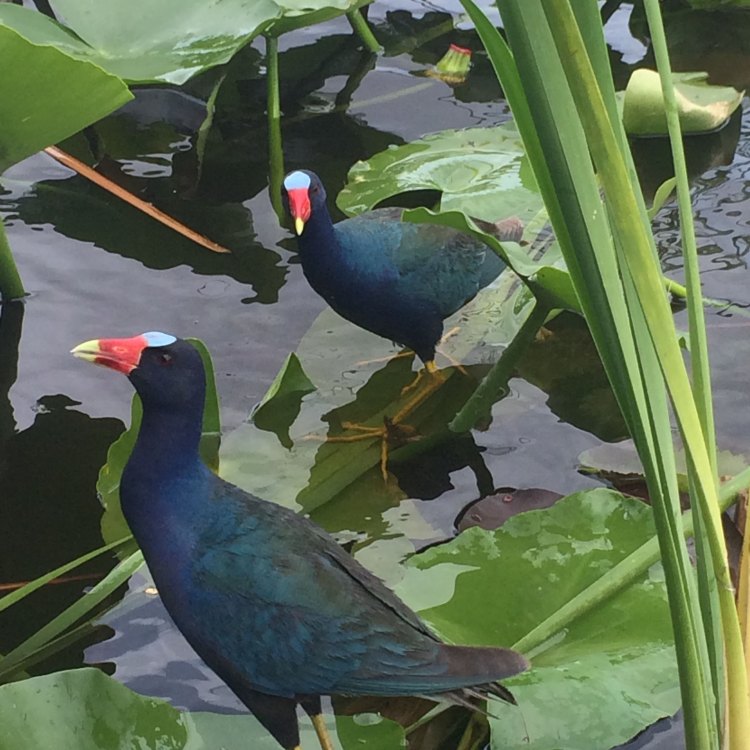
The Beautiful and Mystical Purple Gallinule: A Colorful Bird of the Americas
Disclaimer: The content provided is for informational purposes only. We cannot guarantee the accuracy of the information on this page 100%. All information provided here may change without prior notice.

